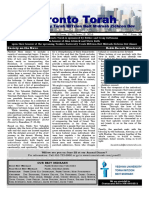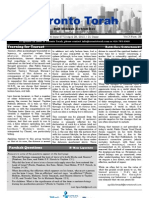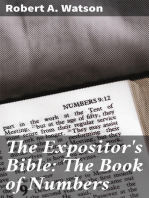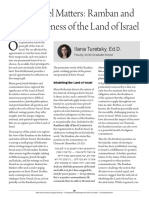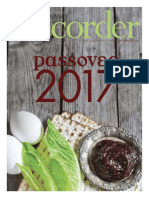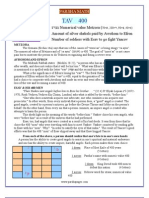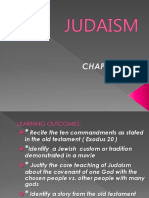From Light To Darkness To Light: This Issue of Toronto Torah Is Dedicated in Honour of Rabbi Mordechai Torczyner
From Light To Darkness To Light: This Issue of Toronto Torah Is Dedicated in Honour of Rabbi Mordechai Torczyner
Uploaded by
outdash2Copyright:
Available Formats
From Light To Darkness To Light: This Issue of Toronto Torah Is Dedicated in Honour of Rabbi Mordechai Torczyner
From Light To Darkness To Light: This Issue of Toronto Torah Is Dedicated in Honour of Rabbi Mordechai Torczyner
Uploaded by
outdash2Original Description:
Original Title
Copyright
Available Formats
Share this document
Did you find this document useful?
Is this content inappropriate?
Copyright:
Available Formats
From Light To Darkness To Light: This Issue of Toronto Torah Is Dedicated in Honour of Rabbi Mordechai Torczyner
From Light To Darkness To Light: This Issue of Toronto Torah Is Dedicated in Honour of Rabbi Mordechai Torczyner
Uploaded by
outdash2Copyright:
Available Formats
Parshat Lech Lecha
11 Cheshvan, 5776/October 24, 2015
Vol. 7 Num. 7
This issue of Toronto Torah is dedicated in honour of Rabbi Mordechai Torczyner
From Light to Darkness to Light
Avraham and Lot, uncle and nephew,
had a very close relationship. Lot was
the son of Avrahams brother Haran.
According to a well-known midrash
(Bereishit Rabbah 38:13), after
Avraham survived Nimrods fiery
furnace, Haran sided with Avrahams
faith in Hashem and was killed in the
same furnace. Lot, having just
witnessed his fathers faith in Hashem,
trusted Avraham despite his fathers
fate and was willing to follow Avraham
to a then-unnamed land. That journey
brought Lot to Canaan.
While Lot is scarcely mentioned in the
early stages of our parshah, we can
trust that he was with Avraham as
Avraham and Sarah were busy
bringing people in Charan to faith in
Hashem (Bereishit 12:5 and Rashi).
Lot must have similarly been in Egypt
as Avraham and Sarah met with
Pharaoh, and watched as Avraham
increased in wealth from that
interaction. Rashi claims that Lots
wealth emerged from his proximity to
Avrahams growing fortune.
(Commentary to Bereishit 13:5)
However, while Lot followed his uncle
from place to place, he did not follow
Avrahams lead in matters of
character. Lots shepherds allowed
their flocks to graze in others fields
and rebuffed Avrahams shepherds
when they pointed out the theft
involved (13:7 and Rashi). [The Talmud
warns that those who raise cattle are
often punished for allowing their
animals to graze in other peoples
property. See Pesachim 50b, and
Tosafot Chullin 84b HaRotzeh.] The rift
between Avraham and Lot led to them
going their separate ways.
Lot chose to go down to Sdom, a place
notorious for the evil its inhabitants
perpetrated. And Lot raised his eyes,
and he saw the entire plain of the
Jordan, that it was entirely watered;
before the Lord destroyed Sdom and
Amorah, like the garden of Hashem, like
the land of Egypt, as you come to
Tzoar. And Lot chose for himself the
entire plain of the Jordan, and Lot
traveled from the east, and they parted
from one another. (Bereishit 13:10-11)
The Hebrew for Lot travelled from the
east is Vayisa Lot miKedem. A similar
phrase was used at the outset of the
rebellion of the Tower of Bavel; Bereishit
11:2 says that the builders travelled
from Kedem. Rabbi Yaakov Ben Asher,
in his Baal
H aT u r im b i b l i cal
commentary, explains that Kedem can
have two meanings:
It can mean from the east.
It can also mean [they left] the One
who preceded the world.
The second interpretation is based on a
midrash which explains, the builders of
the Tower removed themselves from He
who preceded the world, saying, We
have no business with Him or His
Divinity. (Bereishit Rabbah 38:7)
According to this interpretation, both
the builders of the Tower, and Lot,
abandoned G-d. A later midrash (ibid.
41:7) makes a similar comment
regarding Lots travelling away from
Kedem: [Lot] said: I cannot be with
Avraham or with his G-d. Lot thus,
rebels against all the good Avraham had
done for him, and heads down to Sdom.
Rabbi David Ely Grundland
Kedem of Eden, where Adam is placed.
(Bereshit 2:8) When Adam and Chavah
are banished from the garden, a cherub
with a spinning sword is placed to the
Kedem of the garden. (ibid. 3:24) Lot,
instead of aspiring to the spirituality of
Gan Eden, only sees an Eden-like
material bounty available to him.
Having seen his nephew and pupil
depart so far from his own path, why
did Avraham proceed to risk his life to
liberate Lot from captivity in the war of
the kings? (ibid. 14:14-16) One might
suggest that Avraham never gave up on
Lot, but we could also suggest that
Avraham possessed broader vision.
The Talmud (Ketubot 53a) provides us
some relevant insight. Our sages teach
us not to withhold the inheritance of a
bad child in favour of a good one,
because one cannot know what will
become of the following generation.
Perhaps Avraham took this approach,
and therefore he was not willing to
abandon his nephew and brother-inlaw. Indeed, Mashiach descends from
Ruth, a granddaughter of Lot; the man
Avraham saved would become the greatgrandfather of Mashiach.
Some of the greatest victories emerge
out of the darkest places. Let us always
remember that Mashiach is born out of
the darkness; may we merit to welcome
his light, immediately!
dgrundland@torontotorah.com
We might also note that the biblical
Kedem can refer to the Garden of
Eden. The garden is planted in the
OUR BEIT MIDRASH
ROSH BEIT MIDRASH
RABBI MORDECHAI TORCZYNER
SGAN ROSH BEIT MIDRASH
RABBI JONATHAN ZIRING
AVREICHIM RABBI DAVID ELY GRUNDLAND, YISROEL MEIR ROSENZWEIG
CHAVERIM DAR BARUCHIM, YEHUDA EKLOVE, URI FRISCHMAN, AVISHAI GASNER,
SHMUEL GIBLON, MICHAEL IHILCHIK, RYAN JENAH, SHIMMY JESIN, CHEZKY MECKLER,
ZACK MINCER, JOSH PHILLIP, JACOB POSLUNS, SHAI REEF, ARYEH ROSEN, SHLOMO
SABOVICH, ARIEL SHIELDS, DAVID SUTTNER, DAVID TOBIS
We are grateful to
Continental Press 905-660-0311
Book Review: Through an Opaque Lens
Through an Opaque Lens
Rabbi Hayyim Angel
Sephardic Pub. Foundation (2006)
Who is the Author?
Rabbi Hayyim Angel teaches advanced
Tanach courses to undergraduates and
r ab bi ni cal stude n ts at Ye shi va
University, and lectures widely. He
received his B.A. in Jewish Studies, his
M.A. in Bible, his M.S. in Jewish
E d u c a ti o n , a n d h i s r a b b i n i c a l
ordination, from Yeshiva University. He
has published over 100 scholarly
articles, primarily in Tanach, and is the
author or editor of more than ten
books. He previously served for
seventeen years as Rabbi at
Congregation Shearith Israel of New
York.
What is the topic of the book?
Through an Opaque Lens, while
surveying different topics and books in
Tanakh examining issues that range
from a broad attempt to define the
difference between Torah and Neviim
(Prophets) to a very narrow study of the
genealogies in Bereishit has one
uniting and ever-present theme: the
constant striving to achieve the pure
peshat.
The very first essay in the book, which
deals with the effort to understand what
makes Moshes prophecy distinct from
that of other prophets, presents us with
Rabbi Baruch Weintraub
the following underlying theme. Rabbi
Angel argues, based on Rabbeinu
Bachyas commentary to a talmudic
statement that non-Moshe prophets
in fact perceived a combination of
objectivity and subjectivity in their
prophecies. They combined true
perception of G-d with their spiritual
attainments, historical circumstances,
and the needs of their audiences. (pg.
18) Further, he claims, it may be that
the prophets did not perceive this
distortion. He concludes by claiming
that commentators of the Torah were
similarly influenced by these factors,
but that The greater ones humility
and religious character, the greater
ones ability to transcend these
variables that cloud human
perception. (pg. 19)
The essays following are divided into
two sections. In the first, titled
Methodology, Rabbi Angel examines
the work of some (mainly) modern
Tanach commentators such as Rabbi
Elhanan Samet, Rabbi Yehudah
Shaviv and Nechama Leibowitz (but
also Rambam!) examining the extent
to which they followed peshat, and to
what extent their commentaries were
m o ti va te d b y o th e r r e l i gi ou s
concerns.
In the second section of the book,
Rabbi Angel demonstrates how to
613 Mitzvot: #464-466: Ir haNidachat
One of the more frightening sections in the Torah appears in
Devarim 13:13-19, which describes a situation in which an
entire Jewish city in Israel is converted to idol worship. Such
a city is called an ir hanidachat. The Torah commands us to
destroy the city, executing its inhabitants and burning its
property, and to leave it as a ruin eternally. Sefer haChinuch
codifies this in three separate mitzvot:
To burn the city and its contents (Mitzvah 464)
Not to re-build the city as a residential area (#465)
Not to benefit from the citys assets (#466)
The Talmud (Sanhedrin 71a) includes ir hanidachat in a list
of three laws which never were, and never will be; the other
two are the law of tzaraat marks that appear on a home
(Vayikra 14:33-57), and the ben sorer umoreh [the rebellious
pre-teen] (Devarim 21:18-21). Why, then, were these laws
presented in the Torah? The Talmud says, Analyze them,
and receive reward. What is the lesson which is our reward?
Perhaps these three not-for-implementation laws should be
viewed as a set, and the reward is a set of lessons
regarding the building blocks of Jewish life: Family (ben
sorer umoreh), Home (the house with tzaraat) and
Community (ir hanidachat).
Alternatively, the lesson of ir nidachat might be to avoid the
sins which doomed the Canaanites. Canaanite idolatry was
the root of the abuses which caused their eviction from the
Land of Israel, and so you will be evicted from the land for
emulating their ways. (Vayikra 20:23-24)
apply his approach to some specific
subjects. One of these relates directly
to our parshah.
How should we learn faith from the
Avraham narratives?
One of the major articles asks how to
approach Avrahams narratives as a
source from which to learn faith. Rabbi
Angel insists, in accordance with his
method, that rather than impose our
views on the text, we must be open to
its lessons.
While Rabbi Angels approach to these
questions is refreshing and his
answers plausible, one cannot but
wonder if this attitude does not miss a
crucial part of Torah study. The
subjective element in anyones
commentary cannot be denied but
should not necessarily be looked upon
as clouding the lens. Avraham is the
father of the Jewish nation and faith,
but the development and growth of his
ideals did not stop with him.
Throughout the generations, Jewish
thinkers advanced and fleshed out our
conceptions of Jewish faith; the desire
to anchor these developments in the
ancient texts should be seen, in this
reviewers opinion, as a step toward
greater clarity of the ideas behind the
text, not as partitions which separate
us from it.
bweintraub@torontotorah.com
Rabbi Mordechai Torczyner
One might also understand in ir hanidachat a lesson
regarding balancing competing values. The mission of the
Jewish people requires that we return to the land
promised to our ancestors, and that we build and
strengthen communities there. On the other hand, we are
bound by national covenant and personal spiritual
identity to recognize G-d and follow His instructions. The
law of ir hanidachat teaches us to prioritize the
relationship with G-d over those other values.
Even though ir hanidachat is not intended for
implementation, a midrash (Bamidbar Rabbah 14:1)
suggests one historic case of quasi-implementation. After
the city of Yericho fell to the Jews, Yehoshua dedicated the
spoils as cherem, to be left untouched, and he decreed that
the city should never be rebuilt. (Yehoshua 6:16-26)
Commentators differ regarding why Yehoshua did this, and
the aforementioned midrash suggests that Yehoshua saw
Yericho as an ir hanidachat in its corruption and idolatry.
The Torah uses a unique term, beliyaal, to describe this
idolatrous city. This word, which means without any
chance of improvement or without the yoke of Heaven, is
used in Chumash to describe only two situations: the
idolatrous city, and one who refuses to lend money to a
needy person. The Talmud (Ketuvot 68a) deduces from here
that refusing to aid the needy is equivalent to idolatry.
torczyner@torontotorah.com
Visit us at www.torontotorah.com
Biography
Torah and Translation
Rabbi Ephraim Greenblatt
The Synagogue Speech: When and Where?
Rabbi Ezra Goldschmiedt
Rabbi Ephraim Greenblatt, Rivivot Ephraim 1:209:1
Translated by Rabbi Mordechai Torczyner
Rabbi Ephraim Greenblatt was born in
Jerusalem c. 1930. He displayed
potential to become a Torah giant at a
young age, learning in the Mirrer Yeshiva
and then Yeshivat HaDarom under the
likes of Rabbi Chaim Shmulevitz, Rabbi
Eliezer Man Schach and Rabbi Isser
Zalman Meltzer. However, his time in
Israel was cut short at the young age of
eighteen, due to the financial needs of
his parents and nine younger siblings.
He journeyed to America to earn a salary
with which to support them.
Hardly speaking a word of English, he
lived with his grandfather, himself a
respected rabbi, in New Yorks Lower
East Side. There, he found a modest
position in the rabbinate while also
learning under Rabbi Moshe Feinstein.
Rabbi Feinstein took Rabbi Greenblatt
under his wing like his own son, and
eventually approached him with the
charge to strengthen the Jewish
community in Memphis, Tennessee.
Rabbi Greenblatt went there and found
himself overwhelmed the large Jewish
community had all of two shomer
shabbat Jews. Returning to New York
dejected, Rabbi Greenblatt told Rabbi
Feinstein that Memphis was an ir
hanidachat beyond his ability to
develop, to which Rabbi Feinstein
responded that he knew exactly what he
was getting Rabbi Greenblatt into. This
was a place starving for Torah and
growth.
With words of encouragement from his
mentor, Rabbi Greenblatt returned to
Memphis, where he served as Rabbi for
58 years. During that time, he helped
turn Memphis into a thriving Jewish
community; he was responsible for the
religious revival of thousands of nowobservant Jews. Continuing his growth
in learning, Rabbi Greenblatt went on to
become one of North Americas greatest
talmidei chachamim. A visitor to
Memphis once asked Rabbi Greenblatt
the million-dollar question: You could
have been a gadol in Bnei Brak, why are
you here in Memphis? Rabbi Greenblatt
responded, Memphis produces gedolim!
The author of the 7-volume responsa
Rivevot Ephraim, Rabbi Greenblatt
returned to Israel in 2009, and he
continued
teaching
there.
Rabbi
Greenblatt passed away on the 2nd of
Shevat, 5774.
ezragoldschmiedt@gmail.com
Visit us at www.torontotorah.com
,
.
.
I was asked by a Rabbi who accepted a
new position: The previous Rabbi
customarily spoke about the parshah
after they put the Torah down on the
bimah, before they began the [Torah]
reading. He wishes to know whether he
must emulate this, or whether he may
change it.
.
,
.
It appears that whatever one Rabbi does
is not established, by his practice, as a
fixed custom. This is especially true
given that most customs that people
practice have no source; someone just
began doing it. With most customs, the
opposite is true there is no basis for
the custom.
,
,
.
,
,
, ,
.
.
Regarding this particular practice, it
appears that it is disrespectful to the
Torah to place the Torah down and then
speak. Rama (Orach Chaim 147) wrote,
On a day when there are two Torah
scrolls, we do not remove the first before
we place the second on the table, lest
people be distracted from these mitzvot.
If so, we see how careful they were not
to be distracted when the Torah was
out. If so, then when the Rabbi speaks
even though he speaks of the days
parshah there is distraction from the
scroll. If so, then just the opposite, the
Rabbi should speak before they take out
the Torah. And so I remember from my
grandfather, the pious Rabbi, Rabbi
Yitzchak ztl, that he spoke before they
took out the Torah.
,
,
.
,
.
.
And so wrote to me Rabbi Raphael
Zilber, that it would be correct to speak
before they remove the Torah, because it
would not be right to be distracted
afterward. On Shavuot, we find that
after they take out [the Torah] they say
Akdamut, for various reasons, but we
find no other case. And see Darchei
Chaim vShalom 641, who spoke after
they opened the Torah on Shavuot; one
must say that Shavuot is unique, and
this is not done at other times.
.
...
As far as one persons objection about
the practice of speaking with ones back
to the Aron Kodesh, it appears that one
can depend on the Taz (Yoreh Deah
282), who wrote that those who stand to
speak before the Aron Kodesh, with
their backs to the Torah, are not
violating a prohibition. Since the Torah
is inside the Aron Kodesh, it is as
though it was in a different space
This Week in Israeli History: 12 Cheshvan 1898
Meeting of Theodor Herzl and Kaiser Wilhelm II
12 Cheshvan is Sunday
12th
On the
of Cheshvan (October 28), 1898, Theodor Herzl,
the leader of modern Zionism, first petitioned Kaiser
Wilhelm II to support the plan to settle Jews in Israel. He
met him at the agricultural school Mikve Israel, near
Rechovot. Herzl felt that the German leaders endorsement
was critical to achieving international support for the plan.
Due to the historic nature of the moment, the delegation
wanted to ensure there would be photographic evidence of
the meeting. However, the photographs barely captured the
two men. Instead, an iconic picture of the event was created
by superimposing other images into the photo, and it is that
photograph that is seen when reading about records of the
event.
At the first meeting, the Kaiser did not provide much
support for the movement, noting only that the country
would need much water to succeed. However, a more
extensive meeting was carried out on November 2nd of that
Rabbi Jonathan Ziring
year, and there the Kaiser did express his support of the
Zionist dream. As Herzl had desired, this moment did grant
his dream a measure of international recognition. To an
extent, therefore, the plan succeeded. The London Daily Mail
for November 18, 1898, reported An Eastern Surprise:
Important Result of the Kaisers Tour: Sultan and Emperor
Agreed in Palestine: Benevolent Sanction Given to the Zionist
Movement One of the most important results, if not the most
important, of the Kaisers visit to Palestine is the immense
impetus it has given to Zionism, the movement for the return
of the Jews to Palestine
While this was the beginning of the move toward international
recognition, there were to be many steps forward and
backwards before the recognition of the state in 1948. The
importance of international support, and the difficulty of
achieving it, remains a theme in Israeli history even decades
after the official founding of the state.
jziring@torontotorah.com
Weekly Highlights: Oct. 24 Oct. 30 / 11 Cheshvan 17 Cheshvan
Time
Speaker
Topic
Location
Special Notes
After hashkamah
Yisroel Meir Rosenzweig
Seforno on the Parshah
Clanton Park
Derashah
R Mordechai Torczyner
Blue Jay Passion
Ayin lTzion
R Jonathan Ziring
Daf Yomi
BAYT
8:45 AM
R Mordechai Torczyner
Medical Halachah:
OCD in Judaism
BAYT
CME Credit;
Non-doctors welcome
8:45 AM
Jonathan Ziring
Trei Asar
BAYT
Hebrew
9:15 AM
R Shalom Krell
The Book of Shemuel
Associated (North)
Hebrew
Oct. 24
Before minchah
Sun. Oct. 25
Mon. Oct. 26
7:30 PM
Yisroel Meir Rosenzweig A Single Minhag for Israel? Yeshivat Or Chaim
Beit Midrash Night
R David Ely Grundland
Daf Highlights
R Mordechai Torczyner
Medical Halachah
Mrs. Ora Ziring
Womens Beit Midrash
Ulpanat Orot
R Mordechai Torczyner
Job: Chapter 20-21
Shaarei Shomayim
10:00 AM
R Mordechai Torczyner
The Ethical Customer
Week 3: Just Browsing
This week:
At Beth David
Register with
savtaloretta@gmail.com
12:30 PM
R Mordechai Torczyner
Business Ethics:
The Mi shePara Curse
SLF
2300 Yonge St
Lunch served; RSVP
jonathan.hames@slf.ca
Yisroel Meir Rosenzweig
GM Food
Shaarei Tefillah
Mrs. Ora Ziring
Womens Beit Midrash
Ulpanat Orot
7:30 PM
Shaarei Shomayim
Beit Midrash Night
Tue. Oct. 27
10:00 AM
1:30 PM
Wed. Oct. 28
8:00 PM
Thu. Oct. 29
10:00 AM
1:30 PM
R Mordechai Torczyner Yehoshua: Land of Binyamin
49 Michael Ct.
For women only
Yeshivat Or Chaim
Advanced
Fri. Oct. 30
10:30 AM
R Jonathan Ziring
Eruvin: Karmelit
You might also like
- Pirkey AvotDocument125 pagesPirkey AvotPeter Novak100% (3)
- Lessons Learned From Conversion: Rabbi Zvi RommDocument5 pagesLessons Learned From Conversion: Rabbi Zvi Rommoutdash2No ratings yet
- Toronto TorahDocument4 pagesToronto Torahoutdash2No ratings yet
- Details Count: Parashat Naso Sivan 12 5774 May 30, 2015 Vol. 24 No. 32Document4 pagesDetails Count: Parashat Naso Sivan 12 5774 May 30, 2015 Vol. 24 No. 32outdash2No ratings yet
- To Contemplate The Holy: 25 Adar I, 5776/march 5, 2016 Parshat Vayakhel Vol. 7 Num. 26Document4 pagesTo Contemplate The Holy: 25 Adar I, 5776/march 5, 2016 Parshat Vayakhel Vol. 7 Num. 26outdash2No ratings yet
- To Contemplate The Holy: 25 Adar I, 5776/march 5, 2016 Parshat Vayakhel/Shekalim Vol. 7 Num. 26Document4 pagesTo Contemplate The Holy: 25 Adar I, 5776/march 5, 2016 Parshat Vayakhel/Shekalim Vol. 7 Num. 26outdash2No ratings yet
- Shemot: What's in A Name?: 21 Tevet, 5776/january 2, 2016 Parshat Shemot Vol. 7 Num. 17Document4 pagesShemot: What's in A Name?: 21 Tevet, 5776/january 2, 2016 Parshat Shemot Vol. 7 Num. 17outdash2No ratings yet
- UntitledDocument8 pagesUntitledoutdash2No ratings yet
- Beha'alotkha - TransfigurationDocument16 pagesBeha'alotkha - Transfigurationafeioroberta85No ratings yet
- Toronto TorahDocument4 pagesToronto Torahoutdash2No ratings yet
- He Saw No OneDocument4 pagesHe Saw No Oneoutdash2No ratings yet
- NoachDocument2 pagesNoachLivingTorahNo ratings yet
- In Search of A Non-Liberal Humanism: 3 Tammuz, 5775/june 20, 2015 Parshat Korach Vol. 6 Num. 37Document4 pagesIn Search of A Non-Liberal Humanism: 3 Tammuz, 5775/june 20, 2015 Parshat Korach Vol. 6 Num. 37outdash2No ratings yet
- Our Potential: Greater Than The Angels: Hazeh" ("It Came To Pass in That Very Day")Document4 pagesOur Potential: Greater Than The Angels: Hazeh" ("It Came To Pass in That Very Day")outdash2No ratings yet
- T S M A: HE Halshelet: Ark of MbivalenceDocument14 pagesT S M A: HE Halshelet: Ark of MbivalenceArethaNo ratings yet
- The Enduring Meaning of The Covenant of The PatriarchsDocument4 pagesThe Enduring Meaning of The Covenant of The Patriarchsoutdash2No ratings yet
- Creating The Future: 2 Menachem Av, 5775/july 18, 2015 Parshiyot Matot-Masei Vol. 6 Num. 41Document4 pagesCreating The Future: 2 Menachem Av, 5775/july 18, 2015 Parshiyot Matot-Masei Vol. 6 Num. 41outdash2No ratings yet
- Toronto TorahDocument4 pagesToronto Torahoutdash2No ratings yet
- Hidden Identities: 17 Tammuz, 5775/july 4, 2015 Parshat Balak Vol. 6 Num. 39Document4 pagesHidden Identities: 17 Tammuz, 5775/july 4, 2015 Parshat Balak Vol. 6 Num. 39outdash2No ratings yet
- Secret of Brit BookDocument33 pagesSecret of Brit BookDavid Saportas Lièvano100% (1)
- Korach 5778 Sixth IDocument4 pagesKorach 5778 Sixth ISuzy StoneNo ratings yet
- Ki TavoDocument6 pagesKi Tavogavriel76No ratings yet
- The Goal of It AllDocument4 pagesThe Goal of It Alloutdash2No ratings yet
- Toronto TorahDocument4 pagesToronto Torahoutdash2No ratings yet
- Repentance As FreedomDocument4 pagesRepentance As Freedomoutdash2No ratings yet
- Toronto TorahDocument4 pagesToronto Torahoutdash2No ratings yet
- Burning Pharaoh's Wagons: 14 Tevet, 5776/december 26, 2015 Parshat Vayechi Vol. 7 Num. 16Document4 pagesBurning Pharaoh's Wagons: 14 Tevet, 5776/december 26, 2015 Parshat Vayechi Vol. 7 Num. 16outdash2No ratings yet
- The Eternal Message of The Urim and ThumimDocument4 pagesThe Eternal Message of The Urim and Thumimoutdash2No ratings yet
- The Jewish Tradition of AstrologyDocument8 pagesThe Jewish Tradition of AstrologyCaio Mattos BaptistaNo ratings yet
- How Do We Know That Megillah EstherDocument13 pagesHow Do We Know That Megillah EstherYochanan Ezra ben Avraham de'HurstNo ratings yet
- Toronto TorahDocument4 pagesToronto Torahoutdash2No ratings yet
- Society On The Move: 12 Sivan, 5776/june 18, 2016 Parshat Naso Vol. 7 Num. 38Document4 pagesSociety On The Move: 12 Sivan, 5776/june 18, 2016 Parshat Naso Vol. 7 Num. 38outdash2No ratings yet
- 1.10 Spanish Mikketz 5779Document4 pages1.10 Spanish Mikketz 5779e-jajamNo ratings yet
- Parashat KorachDocument3 pagesParashat Korachoutdash2No ratings yet
- UntitledDocument4 pagesUntitledoutdash2No ratings yet
- Maamor - Issa Bemedrash - Chayei Soroh - 5748-1Document28 pagesMaamor - Issa Bemedrash - Chayei Soroh - 5748-1leahNo ratings yet
- Purifying The Past and Proceeding To The Promised LandDocument4 pagesPurifying The Past and Proceeding To The Promised Landoutdash2No ratings yet
- Parshas Parah and Why We Read It: by Ariel Sacknovitz, 11th GradeDocument6 pagesParshas Parah and Why We Read It: by Ariel Sacknovitz, 11th Gradeoutdash2No ratings yet
- Don't Outsmart The Torah: by Eitan Lipsky, 12th GradeDocument6 pagesDon't Outsmart The Torah: by Eitan Lipsky, 12th Gradeoutdash2No ratings yet
- 38 SE KorachDocument6 pages38 SE KorachAdrian CarpioNo ratings yet
- MalachiDocument69 pagesMalachiCris Licsi MantesNo ratings yet
- Who's Crying?: Parashat Nitzavim Elul 28 5776 October 1, 2016 Vol. 25 No. 4Document4 pagesWho's Crying?: Parashat Nitzavim Elul 28 5776 October 1, 2016 Vol. 25 No. 4outdash2No ratings yet
- Understanding The Sins of The Dor Haflagah (Generation of Separation)Document4 pagesUnderstanding The Sins of The Dor Haflagah (Generation of Separation)outdash2No ratings yet
- A Journey Through Torah: An Introduction to God’s Life Instructions for His ChildrenFrom EverandA Journey Through Torah: An Introduction to God’s Life Instructions for His ChildrenNo ratings yet
- Toronto TorahDocument4 pagesToronto Torahoutdash2No ratings yet
- Parshat Korach Rebellion Rabbi Ari KahnDocument7 pagesParshat Korach Rebellion Rabbi Ari Kahngavriel76No ratings yet
- Yutorah Print: Devarim 5774Document8 pagesYutorah Print: Devarim 5774outdash2No ratings yet
- UntitledDocument20 pagesUntitledoutdash2No ratings yet
- Only G-D Is UnblemishedDocument4 pagesOnly G-D Is Unblemishedoutdash2No ratings yet
- Parsha Compendium Bereishit 5771 Advanced (English)Document13 pagesParsha Compendium Bereishit 5771 Advanced (English)reuven_No ratings yet
- Rabbinic Advice in A Confused AgeDocument7 pagesRabbinic Advice in A Confused Ageash.shalom100% (1)
- The Commandments in The Zohar1Document4 pagesThe Commandments in The Zohar1Antony HyltonNo ratings yet
- The Heights of HesedDocument10 pagesThe Heights of HesedHarav Michael ElkohenNo ratings yet
- Toronto TorahDocument4 pagesToronto Torahoutdash2No ratings yet
- Toronto TorahDocument4 pagesToronto Torahoutdash2No ratings yet
- Rav Moshe Sternbuch Duplicity-4Document3 pagesRav Moshe Sternbuch Duplicity-4Daniel EidensohnNo ratings yet
- Chavrusa: Chag Hasemikhah ז"עשתDocument28 pagesChavrusa: Chag Hasemikhah ז"עשתoutdash2No ratings yet
- Parashas Beha'aloscha: 16 Sivan 5777Document4 pagesParashas Beha'aloscha: 16 Sivan 5777outdash2No ratings yet
- Consent and Coercion at Sinai: Rabbi Dr. Jacob J. SchacterDocument3 pagesConsent and Coercion at Sinai: Rabbi Dr. Jacob J. Schacteroutdash2No ratings yet
- 879510Document14 pages879510outdash2No ratings yet
- The Meaning of The Menorah: Complete Tanach)Document4 pagesThe Meaning of The Menorah: Complete Tanach)outdash2No ratings yet
- UntitledDocument12 pagesUntitledoutdash2No ratings yet
- The Surrogate Challenge: Rabbi Eli BelizonDocument3 pagesThe Surrogate Challenge: Rabbi Eli Belizonoutdash2No ratings yet
- UntitledDocument12 pagesUntitledoutdash2No ratings yet
- Torah To-Go: President Richard M. JoelDocument52 pagesTorah To-Go: President Richard M. Joeloutdash2No ratings yet
- The Matan Torah Narrative and Its Leadership Lessons: Dr. Penny JoelDocument2 pagesThe Matan Torah Narrative and Its Leadership Lessons: Dr. Penny Joeloutdash2No ratings yet
- Flowers and Trees in Shul On Shavuot: Rabbi Ezra SchwartzDocument2 pagesFlowers and Trees in Shul On Shavuot: Rabbi Ezra Schwartzoutdash2No ratings yet
- Lessons From Mount Sinai:: The Interplay Between Halacha and Humanity in The Gerus ProcessDocument3 pagesLessons From Mount Sinai:: The Interplay Between Halacha and Humanity in The Gerus Processoutdash2No ratings yet
- I Just Want To Drink My Tea: Mrs. Leah NagarpowersDocument2 pagesI Just Want To Drink My Tea: Mrs. Leah Nagarpowersoutdash2No ratings yet
- Reflections On A Presidential Chavrusa: Lessons From The Fourth Perek of BrachosDocument3 pagesReflections On A Presidential Chavrusa: Lessons From The Fourth Perek of Brachosoutdash2No ratings yet
- Performance of Mitzvos by Conversion Candidates: Rabbi Michoel ZylbermanDocument6 pagesPerformance of Mitzvos by Conversion Candidates: Rabbi Michoel Zylbermanoutdash2No ratings yet
- Shavuot To-Go - 5777 Mrs Schechter - Qq4422a83lDocument2 pagesShavuot To-Go - 5777 Mrs Schechter - Qq4422a83loutdash2No ratings yet
- Nasso: To Receive Via Email VisitDocument1 pageNasso: To Receive Via Email Visitoutdash2No ratings yet
- Yom Hamyeuchas: Rabbi Dr. Hillel DavisDocument1 pageYom Hamyeuchas: Rabbi Dr. Hillel Davisoutdash2No ratings yet
- Kabbalat Hatorah:A Tribute To President Richard & Dr. Esther JoelDocument2 pagesKabbalat Hatorah:A Tribute To President Richard & Dr. Esther Joeloutdash2No ratings yet
- What Happens in Heaven... Stays in Heaven: Rabbi Dr. Avery JoelDocument3 pagesWhat Happens in Heaven... Stays in Heaven: Rabbi Dr. Avery Joeloutdash2No ratings yet
- Experiencing The Silence of Sinai: Rabbi Menachem PennerDocument3 pagesExperiencing The Silence of Sinai: Rabbi Menachem Penneroutdash2No ratings yet
- Chag Hasemikhah Remarks, 5777: President Richard M. JoelDocument2 pagesChag Hasemikhah Remarks, 5777: President Richard M. Joeloutdash2No ratings yet
- The Power of Obligation: Joshua BlauDocument3 pagesThe Power of Obligation: Joshua Blauoutdash2No ratings yet
- Appreciating Moses' GreatnessDocument4 pagesAppreciating Moses' Greatnessoutdash2No ratings yet
- 879446Document5 pages879446outdash2No ratings yet
- Why Israel Matters: Ramban and The Uniqueness of The Land of IsraelDocument5 pagesWhy Israel Matters: Ramban and The Uniqueness of The Land of Israeloutdash2No ratings yet
- José Faur: Modern Judaism, Vol. 12, No. 1. (Feb., 1992), Pp. 23-37Document16 pagesJosé Faur: Modern Judaism, Vol. 12, No. 1. (Feb., 1992), Pp. 23-37outdash2No ratings yet
- A Blessed Life: Rabbi Yehoshua FassDocument3 pagesA Blessed Life: Rabbi Yehoshua Fassoutdash2No ratings yet
- Chavrusa: Chag Hasemikhah ז"עשתDocument28 pagesChavrusa: Chag Hasemikhah ז"עשתoutdash2No ratings yet
- Barmitzvah Test Syllabus: Questions and Answers For The Barmitzvah Test - Laws and CustomsDocument18 pagesBarmitzvah Test Syllabus: Questions and Answers For The Barmitzvah Test - Laws and CustomsYaakov KleinNo ratings yet
- Eisenberg TriennialDocument36 pagesEisenberg TriennialDiego VovchukNo ratings yet
- Pesach MathDocument1 pagePesach MathRabbi Benyomin Hoffman100% (1)
- Rabbi Shimon Kerner: Parashas Ki Savo אבת יכ תשרפDocument2 pagesRabbi Shimon Kerner: Parashas Ki Savo אבת יכ תשרפoutdash2No ratings yet
- Bulletin 74Document6 pagesBulletin 74ITZKHAKNo ratings yet
- The Difference Between Blessing (Bracha) and Prayer (Tefilah)Document10 pagesThe Difference Between Blessing (Bracha) and Prayer (Tefilah)Ridwan OlanrewajuNo ratings yet
- H4C Passover SederDocument61 pagesH4C Passover SederSamira AbdulNo ratings yet
- Friday Night Kiddush QuickGuideDocument2 pagesFriday Night Kiddush QuickGuideGabriel R.No ratings yet
- The Recorder - Winter 2017Document32 pagesThe Recorder - Winter 2017William ClarkNo ratings yet
- Compassion Towards People With Disabilities: The Torah PerspectiveDocument3 pagesCompassion Towards People With Disabilities: The Torah Perspectiveoutdash2No ratings yet
- Hebraic Roots of ChristianityDocument22 pagesHebraic Roots of Christianitypremccc100% (1)
- Miketz 15th December 2012Document2 pagesMiketz 15th December 2012LivingTorahNo ratings yet
- Rabbinic Reference Bible Samples Part IDocument31 pagesRabbinic Reference Bible Samples Part Ijorge villelaNo ratings yet
- Math Supplement To Masechta Eruvin and Additional Notes: Part 1 of 2, Up To 56bDocument240 pagesMath Supplement To Masechta Eruvin and Additional Notes: Part 1 of 2, Up To 56bEliyahuNo ratings yet
- Torah Study On Christmas Eve: University of ScrantonDocument35 pagesTorah Study On Christmas Eve: University of ScrantonGabriel Kanter-WebberNo ratings yet
- AAC May BulletinDocument16 pagesAAC May BulletinAgudas Achim CongregationNo ratings yet
- Kol Hamevaser - Academic TalmudDocument8 pagesKol Hamevaser - Academic TalmudDaniel SultanNo ratings yet
- October 2018 AAC Bulletin Low ResDocument16 pagesOctober 2018 AAC Bulletin Low ResAgudas Achim Congregation100% (1)
- Prayer As A JewDocument217 pagesPrayer As A JewMarcelo Díaz100% (1)
- Adin Even-Israel Steinsaltz - Ta'anit & Megilla, Standard Color-Koren Publishers (2014)Document442 pagesAdin Even-Israel Steinsaltz - Ta'anit & Megilla, Standard Color-Koren Publishers (2014)Sergey Kim100% (1)
- Tav 400Document2 pagesTav 400Rabbi Benyomin HoffmanNo ratings yet
- Chanukah MusingsDocument14 pagesChanukah MusingshirhurimNo ratings yet
- 2 DaDonDocument30 pages2 DaDonNnamdi AzikeNo ratings yet
- JudaismDocument22 pagesJudaismGrace Ann DalaganNo ratings yet
- Torah Wellsprings - Toldos 5782 A4Document18 pagesTorah Wellsprings - Toldos 5782 A4Oscar SternNo ratings yet
- Emet CommandmentsDocument74 pagesEmet CommandmentsTodd D. WebbNo ratings yet
- Parsha Pearls - VayeitzeiDocument2 pagesParsha Pearls - Vayeitzeir bergerNo ratings yet
- The Blessings Book: Siddur Tehillat HDocument21 pagesThe Blessings Book: Siddur Tehillat HShmueli GonzalesNo ratings yet
- Daf Ditty Yoma 50: Timnah As Typology: Hadar Zekenim, Exodus 17:8 (12th Cen - France)Document32 pagesDaf Ditty Yoma 50: Timnah As Typology: Hadar Zekenim, Exodus 17:8 (12th Cen - France)Julian Ungar-SargonNo ratings yet
- Daf Ditty Yoma 67: The Crimson ThreadDocument28 pagesDaf Ditty Yoma 67: The Crimson ThreadJulian Ungar-SargonNo ratings yet


































